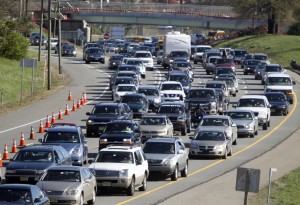Stranded on “3-Mile Island”
It is 7am in the morning, and the second cup of coffee is just not cutting it. However, traffic congestion has been relatively smooth along the tollway and work is not too far away. Then, suddenly, traffic bottlenecks from several lanes down to two, and the quality of the road declines considerably. Essentially, a parking lot has been formed between one stretch of the toll road and another. In the Dallas Fort-Worth gridlock between the two George Bush Tollways is a daily occurrence for thousands who commute to work every morning.
States around the country are looking for better ways to build roads, without taxpayer funds. Thus, a market for tollways has been created that has been able to keep up with the growing demand of growing metropolises. There are drawbacks to this growth as federal law from 1965 prohibits the removal of Interstate Highways in order to build tollways. Kay Bailey Hutchinson (D-Texas) authored a federal amendment to the same law in order to broaden the ban to include exist such as; turning an auxiliary lane, HOV lane into a toll lane or building a toll lane alongside the existing Interstate or State Highway. None of these are taxpayer friendly as the auxiliary and HOV lanes were originally paid for with tax dollars, and for them to become toll lanes would be an inexpensive way for toll companies to collect revenue at the hands of the taxpayers.
SH 161 in particular creates many problems for the taxpayers, toll associations, and the government to deal with. Because the stretch of road only is 3 miles, and is already a connector between two tollways it would be common sense to transform it into a tollway in order to improve traffic congestion and road safety. The road has minimal lighting and there are only two lanes in each direction which are severely deteriorated. One proposal that exists is sponsored by the Texas Department of Transportation (TxDot) which claims that for 3.7 million dollars it can open the shoulder as another lane to ease bottle necking. The loss of the shoulder would create many hazards for accidents along the road so TxDot would build dead end driveways along the road and increase the amount of tow trucks on call to move stalled vehicles quickly. This however is and can only be a short term solution. This does not repair the roads, or increase the amount of lighting, and without a shoulder the danger of the road could increase as drivers can no longer safely pull off at any given time. One long term solution is to build a lane alongside the free lanes in order to add lanes while giving the benefit of the freeway.
The budget is not what it once was because the funds supplied from the federal government relies directly on the gas tax which has not been raised from 18.4 cents per gallon since 1993. Due to inflation, more fuel efficient cars, and now electric cars the fund is getting smaller and smaller. The population of the DFW metroplex increases 1 person every 4 minutes and needs proper highway infrastructure in order to support the continued growth. These issues are not specific to Texas, and every state with a fast growing metroplex is suffering similar growing pains. In order to support this growth a comprehensive federal plan must be created soon or else the amount of goods and services being transported will continue to slow down.
